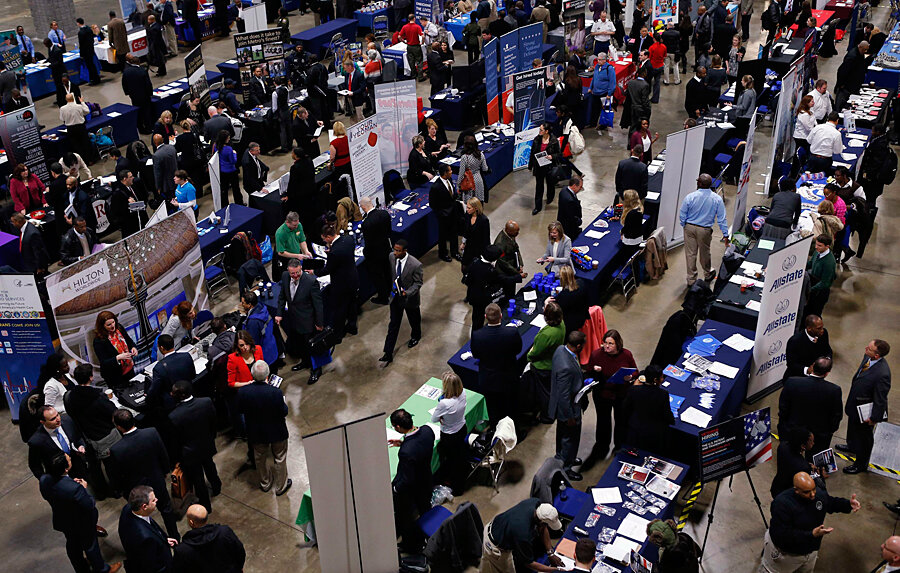Just 74,000 jobs created in December, far below forecasts. What happened?
| Washington
The US unemployment rate fell to 6.7 percent of the work force in December, but the government’s final monthly job-market report of 2013 was a disappointing one nonetheless.
American employers created just 74,000 new jobs during the month, the Labor Department’s survey found. That was far fewer than the nearly 200,000 that many economists had expected.
And although the unemployment rate fell partly because of new jobs, the bigger reason was a continued exodus of people from the labor force as many choose to not even look for work.
The surprising weakness in job creation stemmed partly from the arrival of bad winter weather that disrupted construction and other activities.
“This is a massive slowdown from the 241,000 created in November and 200,000 in October,” writes Paul Edelstein, director of financial economics for IHS Global Insight. But he says “the jobs count could have been closer to 200,000” had the month seen a lower, more typical number of people saying they were unable to work due to weather.
The question is how big that weather impact was.
Mr. Edelstein notes that an unusually large number of Americans, 273,000, said their work was disrupted by weather, twice as many as in a typical December.
But it’s not accurate to simply take that discrepancy (of say, 138,000 people), add them to the 74,000 job count, and sound an all-clear signal. That’s because, for one thing, the jobs count and the weather-effects tally come from two different surveys that the Labor Department conducts each month – one of employers and one of individuals.
Looking at the historical relationships between numbers in the two reports, economists at Morgan Stanley estimate that the temporary weather effects probably did drag down the December job count by 50,000 to 75,000 workers.
That suggests that the gap between the reported job numbers and forecasters’ expectations isn’t as large as it appears at first.
Moreover, the December jobs tally will be updated with a more accurate estimate in about four weeks, so it’s possible that the December numbers will see some upward revision then.
Digesting all this, investors responded to the job numbers without panic. Major US stock indexes were essentially flat as of late Friday morning – in part on the expectation that brighter reports lie ahead in the new year.
Beyond Wall Street, though, the December report has significance for policymakers.
Its relative weakness could give the Federal Reserve some pause as it considers whether to continue to scale back on a program of monthly bond purchases designed to spur economic growth. The Fed began that “taper” last month and may well continue, albeit with some newfound caution.
The report also comes as Congress is weighing whether to revive a program of emergency support for people who have been unemployed longer than half a year. The program, which can extend the duration of unemployment benefits from 26 weeks to 40 weeks or more, expired in December.
The ranks of these “long-term unemployed” have diminished significantly over the past year, by nearly 1 million people, thanks to an improving job market. But with some 3.9 million people still in the category, this group is still much larger than normal.
On average, it’s taking the unemployed well over 26 weeks to find new work, according to numbers tracked by the National Employment Law Project.
The debate in Congress is partly about funding the program, with many Republicans saying its costs should be offset by other measures to keep the federal budget deficit from rising.
The Friday report also provides an initial tally (pending revisions in a month) of the job market’s progress for the whole calendar year of 2013.
It was a year of progress and continued stress for US workers.
The number of people who had work rose significantly: by 2.2 million according the survey of employers and by 1.4 million according to the survey of individual households.
At the same time, the sizable drop in unemployment (the new 6.7 percent figure compares with 7.9 percent in December 2012) has its roots not just in new jobs but in large numbers of people dropping out of the labor force due to discouragement.
The “participation rate,” or share of working-age Americans who are employed or seeking jobs fell over the course of the year by almost a full percentage point: from 63.6 percent to 62.8 percent of civilians 16 and older.
Economists say that decline is partly explained by a large contingent of baby boomers reaching normal retirement age, but also reflects the still-weak job market.






